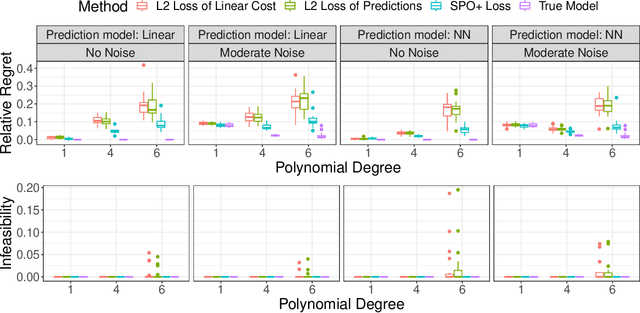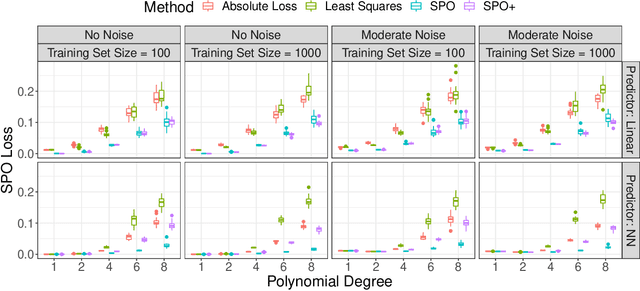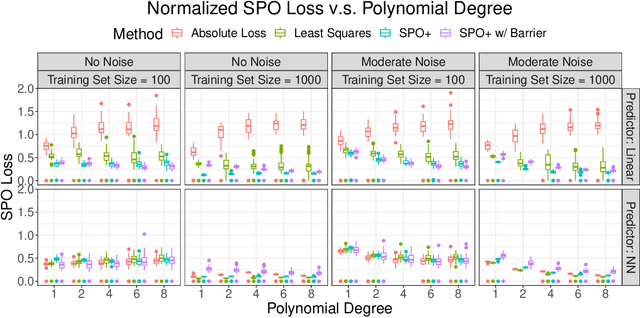Paul Grigas
Max
Smart Surrogate Losses for Contextual Stochastic Linear Optimization with Robust Constraints
May 28, 2025Abstract:We study an extension of contextual stochastic linear optimization (CSLO) that, in contrast to most of the existing literature, involves inequality constraints that depend on uncertain parameters predicted by a machine learning model. To handle the constraint uncertainty, we use contextual uncertainty sets constructed via methods like conformal prediction. Given a contextual uncertainty set method, we introduce the "Smart Predict-then-Optimize with Robust Constraints" (SPO-RC) loss, a feasibility-sensitive adaptation of the SPO loss that measures decision error of predicted objective parameters. We also introduce a convex surrogate, SPO-RC+, and prove Fisher consistency with SPO-RC. To enhance performance, we train on truncated datasets where true constraint parameters lie within the uncertainty sets, and we correct the induced sample selection bias using importance reweighting techniques. Through experiments on fractional knapsack and alloy production problem instances, we demonstrate that SPO-RC+ effectively handles uncertainty in constraints and that combining truncation with importance reweighting can further improve performance.
Self-Supervised Penalty-Based Learning for Robust Constrained Optimization
Mar 07, 2025Abstract:We propose a new methodology for parameterized constrained robust optimization, an important class of optimization problems under uncertainty, based on learning with a self-supervised penalty-based loss function. Whereas supervised learning requires pre-solved instances for training, our approach leverages a custom loss function derived from the exact penalty method in optimization to learn an approximation, typically defined by a neural network model, of the parameterized optimal solution mapping. Additionally, we adapt our approach to robust constrained combinatorial optimization problems by incorporating a surrogate linear cost over mixed integer domains, and a smooth approximations thereof, into the final layer of the network architecture. We perform computational experiments to test our approach on three different applications: multidimensional knapsack with continuous variables, combinatorial multidimensional knapsack with discrete variables, and an inventory management problem. Our results demonstrate that our self-supervised approach is able to effectively learn neural network approximations whose inference time is significantly smaller than the computation time of traditional solvers for this class of robust optimization problems. Furthermore, our results demonstrate that by varying the penalty parameter we are able to effectively balance the trade-off between sub-optimality and robust feasibility of the obtained solutions.
Beyond Discretization: Learning the Optimal Solution Path
Oct 18, 2024Abstract:Many applications require minimizing a family of optimization problems indexed by some hyperparameter $\lambda \in \Lambda$ to obtain an entire solution path. Traditional approaches proceed by discretizing $\Lambda$ and solving a series of optimization problems. We propose an alternative approach that parameterizes the solution path with a set of basis functions and solves a \emph{single} stochastic optimization problem to learn the entire solution path. Our method offers substantial complexity improvements over discretization. When using constant-step size SGD, the uniform error of our learned solution path relative to the true path exhibits linear convergence to a constant related to the expressiveness of the basis. When the true solution path lies in the span of the basis, this constant is zero. We also prove stronger results for special cases common in machine learning: When $\lambda \in [-1, 1]$ and the solution path is $\nu$-times differentiable, constant step-size SGD learns a path with $\epsilon$ uniform error after at most $O(\epsilon^{\frac{1}{1-\nu}} \log(1/\epsilon))$ iterations, and when the solution path is analytic, it only requires $O\left(\log^2(1/\epsilon)\log\log(1/\epsilon)\right)$. By comparison, the best-known discretization schemes in these settings require at least $O(\epsilon^{-1/2})$ discretization points (and even more gradient calls). Finally, we propose an adaptive variant of our method that sequentially adds basis functions and demonstrates strong numerical performance through experiments.
Binary Classification with Instance and Label Dependent Label Noise
Jun 06, 2023Abstract:Learning with label dependent label noise has been extensively explored in both theory and practice; however, dealing with instance (i.e., feature) and label dependent label noise continues to be a challenging task. The difficulty arises from the fact that the noise rate varies for each instance, making it challenging to estimate accurately. The question of whether it is possible to learn a reliable model using only noisy samples remains unresolved. We answer this question with a theoretical analysis that provides matching upper and lower bounds. Surprisingly, our results show that, without any additional assumptions, empirical risk minimization achieves the optimal excess risk bound. Specifically, we derive a novel excess risk bound proportional to the noise level, which holds in very general settings, by comparing the empirical risk minimizers obtained from clean samples and noisy samples. Second, we show that the minimax lower bound for the 0-1 loss is a constant proportional to the average noise rate. Our findings suggest that learning solely with noisy samples is impossible without access to clean samples or strong assumptions on the distribution of the data.
Active Learning in the Predict-then-Optimize Framework: A Margin-Based Approach
May 11, 2023Abstract:We develop the first active learning method in the predict-then-optimize framework. Specifically, we develop a learning method that sequentially decides whether to request the "labels" of feature samples from an unlabeled data stream, where the labels correspond to the parameters of an optimization model for decision-making. Our active learning method is the first to be directly informed by the decision error induced by the predicted parameters, which is referred to as the Smart Predict-then-Optimize (SPO) loss. Motivated by the structure of the SPO loss, our algorithm adopts a margin-based criterion utilizing the concept of distance to degeneracy and minimizes a tractable surrogate of the SPO loss on the collected data. In particular, we develop an efficient active learning algorithm with both hard and soft rejection variants, each with theoretical excess risk (i.e., generalization) guarantees. We further derive bounds on the label complexity, which refers to the number of samples whose labels are acquired to achieve a desired small level of SPO risk. Under some natural low-noise conditions, we show that these bounds can be better than the naive supervised learning approach that labels all samples. Furthermore, when using the SPO+ loss function, a specialized surrogate of the SPO loss, we derive a significantly smaller label complexity under separability conditions. We also present numerical evidence showing the practical value of our proposed algorithms in the settings of personalized pricing and the shortest path problem.
Online Contextual Decision-Making with a Smart Predict-then-Optimize Method
Jun 15, 2022

Abstract:We study an online contextual decision-making problem with resource constraints. At each time period, the decision-maker first predicts a reward vector and resource consumption matrix based on a given context vector and then solves a downstream optimization problem to make a decision. The final goal of the decision-maker is to maximize the summation of the reward and the utility from resource consumption, while satisfying the resource constraints. We propose an algorithm that mixes a prediction step based on the "Smart Predict-then-Optimize (SPO)" method with a dual update step based on mirror descent. We prove regret bounds and demonstrate that the overall convergence rate of our method depends on the $\mathcal{O}(T^{-1/2})$ convergence of online mirror descent as well as risk bounds of the surrogate loss function used to learn the prediction model. Our algorithm and regret bounds apply to a general convex feasible region for the resource constraints, including both hard and soft resource constraint cases, and they apply to a wide class of prediction models in contrast to the traditional settings of linear contextual models or finite policy spaces. We also conduct numerical experiments to empirically demonstrate the strength of our proposed SPO-type methods, as compared to traditional prediction-error-only methods, on multi-dimensional knapsack and longest path instances.
Integrated Conditional Estimation-Optimization
Oct 24, 2021


Abstract:Many real-world optimization problems involve uncertain parameters with probability distributions that can be estimated using contextual feature information. In contrast to the standard approach of first estimating the distribution of uncertain parameters and then optimizing the objective based on the estimation, we propose an integrated conditional estimation-optimization (ICEO) framework that estimates the underlying conditional distribution of the random parameter while considering the structure of the optimization problem. We directly model the relationship between the conditional distribution of the random parameter and the contextual features, and then estimate the probabilistic model with an objective that aligns with the downstream optimization problem. We show that our ICEO approach is asymptotically consistent under moderate regularity conditions and further provide finite performance guarantees in the form of generalization bounds. Computationally, performing estimation with the ICEO approach is a non-convex and often non-differentiable optimization problem. We propose a general methodology for approximating the potentially non-differentiable mapping from estimated conditional distribution to the optimal decision by a differentiable function, which greatly improves the performance of gradient-based algorithms applied to the non-convex problem. We also provide a polynomial optimization solution approach in the semi-algebraic case. Numerical experiments are also conducted to show the empirical success of our approach in different situations including with limited data samples and model mismatches.
Risk Bounds and Calibration for a Smart Predict-then-Optimize Method
Aug 19, 2021


Abstract:The predict-then-optimize framework is fundamental in practical stochastic decision-making problems: first predict unknown parameters of an optimization model, then solve the problem using the predicted values. A natural loss function in this setting is defined by measuring the decision error induced by the predicted parameters, which was named the Smart Predict-then-Optimize (SPO) loss by Elmachtoub and Grigas [arXiv:1710.08005]. Since the SPO loss is typically nonconvex and possibly discontinuous, Elmachtoub and Grigas [arXiv:1710.08005] introduced a convex surrogate, called the SPO+ loss, that importantly accounts for the underlying structure of the optimization model. In this paper, we greatly expand upon the consistency results for the SPO+ loss provided by Elmachtoub and Grigas [arXiv:1710.08005]. We develop risk bounds and uniform calibration results for the SPO+ loss relative to the SPO loss, which provide a quantitative way to transfer the excess surrogate risk to excess true risk. By combining our risk bounds with generalization bounds, we show that the empirical minimizer of the SPO+ loss achieves low excess true risk with high probability. We first demonstrate these results in the case when the feasible region of the underlying optimization problem is a polyhedron, and then we show that the results can be strengthened substantially when the feasible region is a level set of a strongly convex function. We perform experiments to empirically demonstrate the strength of the SPO+ surrogate, as compared to standard $\ell_1$ and squared $\ell_2$ prediction error losses, on portfolio allocation and cost-sensitive multi-class classification problems.
Joint Online Learning and Decision-making via Dual Mirror Descent
Apr 20, 2021



Abstract:We consider an online revenue maximization problem over a finite time horizon subject to lower and upper bounds on cost. At each period, an agent receives a context vector sampled i.i.d. from an unknown distribution and needs to make a decision adaptively. The revenue and cost functions depend on the context vector as well as some fixed but possibly unknown parameter vector to be learned. We propose a novel offline benchmark and a new algorithm that mixes an online dual mirror descent scheme with a generic parameter learning process. When the parameter vector is known, we demonstrate an $O(\sqrt{T})$ regret result as well an $O(\sqrt{T})$ bound on the possible constraint violations. When the parameter is not known and must be learned, we demonstrate that the regret and constraint violations are the sums of the previous $O(\sqrt{T})$ terms plus terms that directly depend on the convergence of the learning process.
Stochastic In-Face Frank-Wolfe Methods for Non-Convex Optimization and Sparse Neural Network Training
Jun 09, 2019



Abstract:The Frank-Wolfe method and its extensions are well-suited for delivering solutions with desirable structural properties, such as sparsity or low-rank structure. We introduce a new variant of the Frank-Wolfe method that combines Frank-Wolfe steps and steepest descent steps, as well as a novel modification of the "Frank-Wolfe gap" to measure convergence in the non-convex case. We further extend this method to incorporate in-face directions for preserving structured solutions as well as block coordinate steps, and we demonstrate computational guarantees in terms of the modified Frank-Wolfe gap for all of these variants. We are particularly motivated by the application of this methodology to the training of neural networks with sparse properties, and we apply our block coordinate method to the problem of $\ell_1$ regularized neural network training. We present the results of several numerical experiments on both artificial and real datasets demonstrating significant improvements of our method in training sparse neural networks.
 Add to Chrome
Add to Chrome Add to Firefox
Add to Firefox Add to Edge
Add to Edge